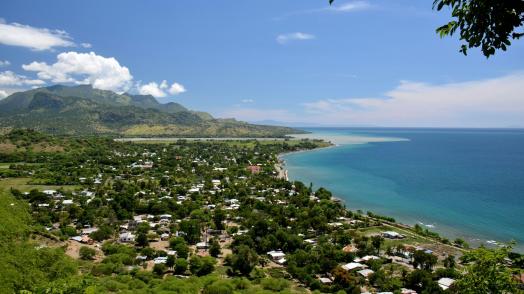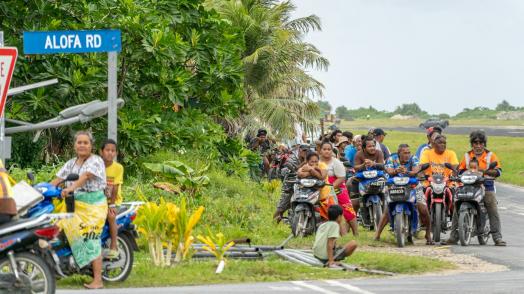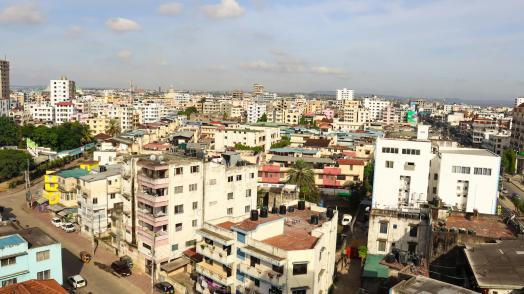The Organization of African, Caribbean and Pacific States (OACPS) represents 79 Member States that are among the most vulnerable countries to the impact of natural hazards, which are expected to become more frequent and severe as the impact of climate change is increasingly felt. Yet, the capacity of ACP states to prepare for and respond to these hazards is already extremely strained.
Each ACP region faces its own set of challenges. Climate-informed policies and investments are essential to how African countries must contend with a growing and urbanizing population’s vulnerability to natural hazards. Meanwhile, countries in the Caribbean are confronting increased financial exposure in the wake of the COVID-19 pandemic and years of unstable growth rates. And for Pacific states, rising sea levels threaten the very existence of low-lying atoll island nations.
Learn more about the program
The ACP-EU Disaster Risk Management Program is a partnership of the European Union (EU), the Organization of African, Caribbean and Pacific States (OACPS), GFDRR and the World Bank. The objective of the Program is to contribute to reducing the impact of disasters caused by natural hazards, including those related to climate change and epidemics, and increase resilience in African, Caribbean and Pacific (ACP) countries to support their efforts to implement the Sendai Framework for Disaster Risk Reduction 2015-2030.
The Program builds on the success of previous cooperation involving the OACPS Secretariat, the EU, and the World Bank-GFDRR through the ACP-EU Natural Disaster Risk Reduction (NDRR) Program, an endeavor that has ensured a coordinated approach to strengthening climate and disaster resilience in ACP countries.
The Program has four components:
- Component 1: Strengthen African Regional Institutions (RECs) Capacities. Provision of technical assistance, through knowledge creation and sharing, and capacity building, to the Economic Community of Central African States (ECCAS), the Economic Community of West African States (ECOWAS), and the Intergovernmental Authority for Development (IGAD), with the aim of strengthening their role in disaster risk reduction and disaster response.
- Component 2: Mainstream DRR and CCA into national and priority sector policies and investment planning. Provision of demand-driven support to ACP countries to provide the support necessary to mainstream disaster risk reduction and climate change adaptation in government policy and action. This aims at improving the design and creation of disaster risk financing tools and strategies, investment planning procedures, decision making capabilities, and other activities that enhance resilience and preparedness. Such efforts also support ACP countries in their efforts to attract additional financing for resilience investments.
- Component 3: Improve urban and peri-urban resilience mechanisms in Central, Eastern and Western targeted African cities. Provision of dedicated support to Central, Eastern and Western African cities to address local urban climate and disaster risks. This demand-driven component seeks to coordinate with, and complement, existing programs from the World Bank, the European Union and other partners.
- Component 4: Operational early warning systems in targeted ACP regions and countries. In alignment with the Climate Risk and Early Warning Systems Initiative (CREWS), the Program is working to ensure that the necessary skills, processes, institutions and partnerships are in place to provide more accurate, timely and exploitable forecasting products for officials, the private sector and end-users.


The Program is funded by the European Union and managed by the GFDRR. Activities are implemented by World Bank teams in close collaboration with the European Commission’s DG International Partnerships, Delegations of the European Union to ACP states, as well as beneficiary countries regional organizations, and development partners.
The ACP-EU DRM program is part of the 11th European Development Fund (EDF) Intra-ACP Disaster Risk Reduction Program, implemented by regional organizations and development partners. The OACPS Secretariat leads the coordination of the overall 11th EDF program.
Actions that focus on the improvement of hydrometeorological services will be conducted in partnership with the CREWS Initiative.
Component 1: Strengthen African Regional Institutions (RECs) Capacities.
- Strengthening ECCAS capacities in Disaster Risk Management and Climate Change
- Strengthening ECOWAS’ Capacities in Disaster Risk Management and Climate Change
- IGAD - Strengthening capacities in Disaster Risk Management and Climate Change
Component 2: Mainstream DRR and CCA into national and priority sector policies and investment planning.
- Benin - Building Climate and Disaster Resilience
- Côte d'Ivoire – Increasing resilience through improved urban infrastructure operation, maintenance practices and disaster risk management
- Dominica – Strengthening Resilience of Infrastructure
- Dominican Republic – Enhancing resilient and inclusive infrastructure development, territorial planning and disaster preparedness
- Grenada - Enhancing critical infrastructure resilience and capacities of key implementing agencies
- Haiti – Reinforcing Preparedness and Response Capacity, and Promoting Resilient Built Environments
- Jamaica - Enhancing the Resilience of Urban Infrastructure to Climate Change
- Kenya – Enhancing Infrastructure Resilience in Mombasa Metropolitan Area
- Kiribati - Strengthening climate and disaster risk informed spatial planning and land development
- Namibia – Enhancing Urban Resilience and Housing for Sustainable Development
- Nigeria – Strengthening DRM Institutional Framework and Enhance Community Resilience
- Pacific Region: Regional adaptive urbanization and climate risk analytics and knowledge exchange
- Pacific Region and Fiji – Enhancing Regional Collaboration for Disaster and Climate Resilience
- Republic of the Marshall Islands - Strengthening resilient urbanization and public facilities
- Rwanda - Strengthening the legal, Institutional and Technical Capacity to Manage Climate and Disasters Risks, and Health Emergencies
- Saint Vincent and the Grenadines - Enhancing disaster resilience of critical infrastructure
- Samoa - Enhancing resilient public facilities
- Saint Lucia - Defining a framework for enhancing urban resilience in Castries and national emergency preparedness and response systems
- Solomon Islands - Strengthening policy framework and capacity building for resilience
- Tanzania - Planning and Policies for Resilience in Dar es Salaam
- Timor-Leste - Strengthening urban resilience, policy frameworks and capacities for disaster risk reduction
- Tonga - Enhancing Resilient Education Facilities
- Tuvalu – Strengthening disaster and climate resilience of public facilities
- Vanuatu: Strengthening Urban Resilience Settlements
- Zambia – Strengthening the Disaster Risk Management Framework and Mainstreaming Disaster Risk Management into Priority Sectors
Component 3: Improve urban and peri-urban resilience mechanisms in Central, Eastern and Western targeted African cities.
- Burkina Faso - Mainstreaming Resilience in Urban Management, Mobility Infrastructure, and Services
- Burundi - Strengthening Urban Resilience
- Cabo Verde - Strengthening Resilient Territorial Planning and Development
- Ethiopia – Strengthening the Understanding of Urban Disaster Risk in Secondary Cities
- Mauritania - Strengthening urban resilience and disaster risk management in Nouakchott and secondary cities
- Somalia – Strengthening Climate Resilience in Urban Settlements
- Uganda - Scaling up resilience in Uganda’s municipalities and cities
Component 4: Operational early warning systems in targeted ACP regions and countries.
- Dominica – Strengthening Resilience of Systems
- Dominican Republic – Enhancing resilient and inclusive early warning systems
- Haiti – Consolidating Early Warning Systems
- Saint Vincent and the Grenadines - Enhancing emergency preparedness and response systems
- Kiribati - Strengthening multi hazard warning systems
- Pacific Region and Fiji - Strengthen Multi-Hazard Early Warning Systems
- Republic of Marshall Islands - National-Level Disaster Preparedness and Response
- Samoa - Enhancing multi-hazard early warning systems
- São Tomé and Príncipe – Island Resilience: Enhancing Early Warning Systems for Climate Adaptation
- Tonga - Enhancing Impact-based Multi-hazard Early Warning Systems
- Tuvalu – Strengthening Preparedness and Early Warning Systems
Documents
- Summary report: Intra-ACP DRR Programme Side-Event “Resilient Together” Highlights Progress and Way Forward on Governance, Investment and Early Warning Systems. Geneva, 2 June 2025.
- Newsletter: Launched in celebration of the International Day for Disaster Risk Reduction 2025, highlighting the theme "Fund Resilience, Not Disasters."
Videos
- The Intra-ACP DRR Program: The 79 members of the OACPS are amongst the most vulnerable countries to the effects of climate change and natural hazards. This video summarizes how the Intra-ACP DRR Program is bringing together eight multi-lateral and regional partners to reduce this impact and increase the resilience of ACP countries. See the promo version.
- Building Resilience Across Africa, the Caribbean, and the Pacific: GFDRR Practice Manager Niels Holm-Nielsen emphasizes how GFDRR provides technical assistance to help countries integrate disaster risk management into their development planning and financing priorities in partnership with the World Bank and the European Commission’s Global Gateway initiative.
Stories




